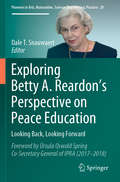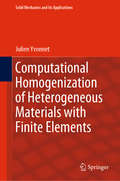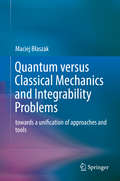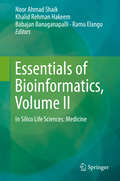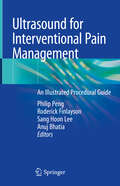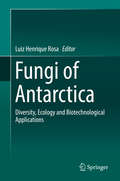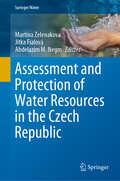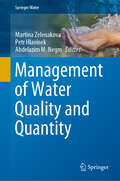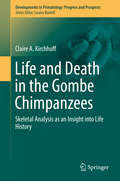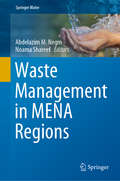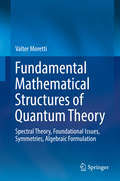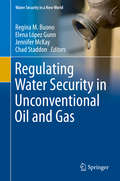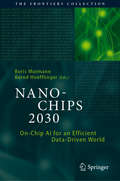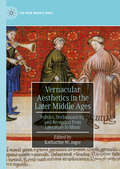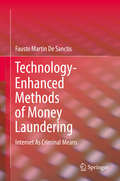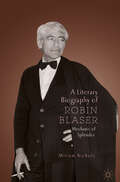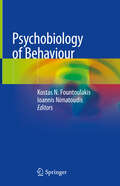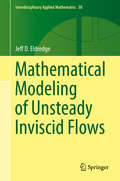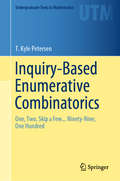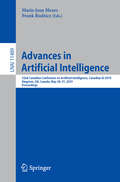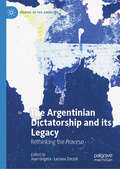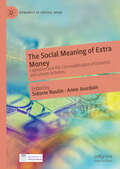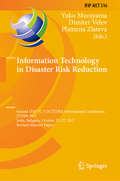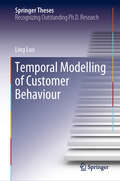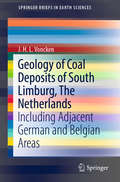- Table View
- List View
Exploring Betty A. Reardon’s Perspective on Peace Education: Looking Back, Looking Forward (Pioneers in Arts, Humanities, Science, Engineering, Practice #20)
by Dale T. SnauwaertThis book presents commentaries by a leading international group of peace education scholars and practitioners concerning Reardon’s peace education theory and intellectual legacy. The guiding question throughout the book is: How can her foundational work be used to advance the theory and practice of peace education? In an attempt to find answers, the contributing authors explore three general areas of inquiry: (1) Theoretical Foundations of Peace and Human Rights Education; (2) Feminism and the Gender Perspective as Pathways of Transformation Toward Peace and Justice; and (3) Peace Education Pedagogy and Practices. A contemplative commentary by Reardon herself rounds out the coverage
Computational Homogenization of Heterogeneous Materials with Finite Elements (Solid Mechanics and Its Applications #258)
by Julien YvonnetThis monograph provides a concise overview of the main theoretical and numerical tools to solve homogenization problems in solids with finite elements. Starting from simple cases (linear thermal case) the problems are progressively complexified to finish with nonlinear problems. The book is not an overview of current research in that field, but a course book, and summarizes established knowledge in this area such that students or researchers who would like to start working on this subject will acquire the basics without any preliminary knowledge about homogenization. More specifically, the book is written with the objective of practical implementation of the methodologies in simple programs such as Matlab. The presentation is kept at a level where no deep mathematics are required.
Quantum versus Classical Mechanics and Integrability Problems: towards a unification of approaches and tools
by Maciej BłaszakThis accessible monograph introduces physicists to the general relation between classical and quantum mechanics based on the mathematical idea of deformation quantization and describes an original approach to the theory of quantum integrable systems developed by the author.The first goal of the book is to develop of a common, coordinate free formulation of classical and quantum Hamiltonian mechanics, framed in common mathematical language.In particular, a coordinate free model of quantum Hamiltonian systems in Riemannian spaces is formulated, based on the mathematical idea of deformation quantization, as a complete physical theory with an appropriate mathematical accuracy.The second goal is to develop of a theory which allows for a deeper understanding of classical and quantum integrability. For this reason the modern separability theory on both classical and quantum level is presented. In particular, the book presents a modern geometric separability theory, based on bi-Poissonian and bi-presymplectic representations of finite dimensional Liouville integrable systems and their admissible separable quantizations.The book contains also a generalized theory of classical Stäckel transforms and the discussion of the concept of quantum trajectories.In order to make the text consistent and self-contained, the book starts with a compact overview of mathematical tools necessary for understanding the remaining part of the book. However, because the book is dedicated mainly to physicists, despite its mathematical nature, it refrains from highlighting definitions, theorems or lemmas.Nevertheless, all statements presented are either proved or the reader is referred to the literature where the proof is available.
Essentials of Bioinformatics, Volume II: In Silico Life Sciences: Medicine
by Noor Ahmad Shaik Khalid Rehman Hakeem Babajan Banaganapalli Ramu ElangoBioinformatics is an integrative field of computer science, genetics, genomics, proteomics, and statistics, which has undoubtedly revolutionized the study of biology and medicine in past decades. It mainly assists in modeling, predicting and interpreting large multidimensional biological data by utilizing advanced computational methods. Despite its enormous potential, bioinformatics is not widely integrated into the academic curriculum as most life science students and researchers are still not equipped with the necessary knowledge to take advantage of this powerful tool. Hence, the primary purpose of our book is to supplement this unmet need by providing an easily accessible platform for students and researchers starting their career in life sciences. This book aims to avoid sophisticated computational algorithms and programming. Instead, it focuses on simple DIY analysis and interpretation of biological data with personal computers. Our belief is that once the beginners acquire these basic skillsets, they will be able to handle most of the bioinformatics tools for their research work and to better understand their experimental outcomes.Our second title of this volume set In Silico Life Sciences: Medicine provides hands-on experience in analyzing high throughput molecular data for the diagnosis, prognosis, and treatment of monogenic or polygenic human diseases. The key concepts in this volume include risk factor assessment, genetic tests and result interpretation, personalized medicine, and drug discovery. This volume is expected to train readers in both single and multi-dimensional biological analysis using open data sets, and provides a unique learning experience through clinical scenarios and case studies.
Ultrasound for Interventional Pain Management: An Illustrated Procedural Guide
by Philip Peng Roderick Finlayson Sang Hoon Lee Anuj BhatiaDue to a wide-spread developing interest in ultrasound-guided pain intervention by clinicians, the demand for a practical reference material on this topic has grown simultaneously. This book thoroughly satisfies the need for such a reference, as it contains text written by experts in the field and a multitude of unique, educational illustrations. Spinal pain, the musculoskeletal system, and peripheral structures function as the fundamental items of discussion across three divided sections. In order to augment the reader’s learning experience, the high-quality images found within each chapter provide step-by-step guidance on the various ultrasound scanning procedural processes. Additionally, tips and pearls for scan and injection supplement each chapter conclusion. Ultrasound for Interventional Pain Management: An Illustrated Procedural Guide is a pragmatic, indispensable resource that helps interested clinical practitioners enhance their visual memory and overall understanding of this method.
Fungi of Antarctica: Diversity, Ecology and Biotechnological Applications
by Luiz Henrique RosaThis book focuses on the fungi found in one of the most pristine regions on Earth: Antarctica. It discusses the fungal occurrence in all substrates of the region, including soil, seawater, lake and marine sediments, rocks, ice, and snow. It also addresses the impact of climate changes on these organisms, the genomic techniques developed to study them, and how a number of compounds, such as antibiotics and enzymes, produced by the Antarctic fungi can be used in medicine, agriculture and the chemical industry.
Assessment and Protection of Water Resources in the Czech Republic (Springer Water)
by Martina Zelenakova Jitka Fialová Abdelazim M. NegmThis book gathers technical and scientific contributions from leading researchers, academics, and lecturers, focusing on water management, water pollution and water structures in the Czech Republic. It discusses a variety of water resources management issues, from stormwater management in urban areas, water quantity, hydraulics structures and hydrodynamic modeling, to flood protection, presenting state-of-the-art developments for addressing a range of problems. Edited and authored by pioneers in the field who have been at the cutting edge of water management development in the Czech Republic, this book is of interest to environmental professionals, including scientists and policymakers both in the Czech Republic and around the globe.
Management of Water Quality and Quantity (Springer Water)
by Martina Zelenakova Petr Hlavínek Abdelazim M. NegmThis book focuses on water pollution, water management and water structures. Presenting contributions on water quality and quantity issues from the engineering point of view, it discusses a variety of issues, from storm water management in urban areas and water quantity, to hydraulic structures, hydrodynamic modeling and flood protection. The book also provides state-of-the-art insights, which that can be used to effectively solve a variety of problems in integrated water resources management, and introduces the latest research advances. Edited and authored by pioneers in the field who have been at the forefront of water management development in the Czech Republic, this book is a valuable resource for environmental professionals, including scientists and policymakers, interested in water-related issues both in the Czech Republic and elsewhere.
Life and Death in the Gombe Chimpanzees: Skeletal Analysis as an Insight into Life History (Developments in Primatology: Progress and Prospects)
by Claire A. KirchhoffThis book addresses how skeletons can inform us about behavior by describing skeletal lesions in the Gombe chimpanzees, relating them to known life histories whenever possible, and analyzing demographic patterns in the sample. This is of particular interest to both primatologists and skeletal analysts who have benefited from published data on a smaller, earlier skeletal sample from Gombe. The Gombe skeletal collection is the largest collection of wild chimpanzees with known life histories in existence, and this work significantly expands the skeletal sample from this long-term research site (49 chimpanzees). The book explores topics of general interest to skeletal analysts such as demographic patterns, which injuries leave signs on the skeleton, and rates of healing, and discusses both qualitative and quantitative analysis of the patterning of lesions. The book presents the data in a narrative style similar to that employed in Dr. Goodall’s seminal work The Chimpanzees of Gombe. Readers already familiar with the Gombe chimpanzees are likely to appreciate summaries of life events correlated to observable skeletal features. The book is especially relevant at this time to remind primate conservationists of the importance of the isolated chimpanzee population at Gombe National Park as well as the availability of the skeletons for study, both within the park itself as well as at the University of Minnesota.
Waste Management in MENA Regions (Springer Water)
by Abdelazim M. Negm Noama ShareefThe book presents the state-of-the-art document describing the knowledge, data, cost-effectiveness and technologies employed to manage the waste in several countries such as Morocco, Tunisia, Egypt, Jordon, Syria, Palestine, Lebanon, and Yemen. It covers diverse topics including the status of the waste in the region, solid waste management, solid waste recovery and disposal, the use of the agricultural waste in feeding poultry, sludge disposal and management, wastewater treatment and energy production. Also, the book explains how waste management systems are becoming more complex in many countries with the move from landfill-based to resource recovery-based solutions following the setting of international and national targets to divert waste from landfill and to increase recycling and recovery rates. Besides, this book also evaluates the environmental legislation in the selected countries and suggests new performance enhancements. This book is of interest to environmental professionals including scientists and policymakers in the Middle East, North Africa, and areas with similar features.
Fundamental Mathematical Structures of Quantum Theory: Spectral Theory, Foundational Issues, Symmetries, Algebraic Formulation
by Valter MorettiThis textbook presents in a concise and self-contained way the advanced fundamental mathematical structures in quantum theory. It is based on lectures prepared for a 6 months course for MSc students. The reader is introduced to the beautiful interconnection between logic, lattice theory, general probability theory, and general spectral theory including the basic theory of von Neumann algebras and of the algebraic formulation, naturally arising in the study of the mathematical machinery of quantum theories. Some general results concerning hidden-variable interpretations of QM such as Gleason's and the Kochen-Specker theorems and the related notions of realism and non-contextuality are carefully discussed. This is done also in relation with the famous Bell (BCHSH) inequality concerning local causality.Written in a didactic style, this book includes many examples and solved exercises.The work is organized as follows. Chapter 1 reviews some elementary facts and properties of quantum systems. Chapter 2 and 3 present the main results of spectral analysis in complex Hilbert spaces. Chapter 4 introduces the point of view of the orthomodular lattices' theory. Quantum theory form this perspective turns out to the probability measure theory on the non-Boolean lattice of elementary observables and Gleason's theorem characterizes all these measures. Chapter 5 deals with some philosophical and interpretative aspects of quantum theory like hidden-variable formulations of QM. The Kochen-Specker theorem and its implications are analyzed also in relation BCHSH inequality, entanglement, realism, locality, and non-contextuality. Chapter 6 focuses on the algebra of observables also in the presence of superselection rules introducing the notion of von Neumann algebra. Chapter 7 offers the idea of (groups of) quantum symmetry, in particular, illustrated in terms of Wigner and Kadison theorems. Chapter 8 deals with the elementary ideas and results of the so called algebraic formulation of quantum theories in terms of both *-algebras and C*-algebras.This book should appeal to a dual readership: on one hand mathematicians that wish to acquire the tools that unlock the physical aspects of quantum theories; on the other physicists eager to solidify their understanding of the mathematical scaffolding of quantum theories.
Regulating Water Security in Unconventional Oil and Gas (Water Security in a New World)
by Regina M. Buono Elena López Gunn Jennifer McKay Chad StaddonThis book addresses the need for deeper understanding of regulatory and policy regimes around the world in relation to the use of water for the production of ‘unconventional’ hydrocarbons, including shale gas, coal bed methane and tight oil, through hydraulic fracturing. Legal, policy, political and regulatory issues surrounding the use of water for hydraulic fracturing are present at every stage of operations. Operators and regulators must understand the legal, political and hydrological contexts of their surroundings, procure water for use in the fracturing and extraction processes, gain community cooperation or confront social resistance around water, collect flow back and produced water, and dispose of these wastewaters safely. By analysing and comparing different approaches to these issues from around the globe, this volume gleans insights into how policy, best practices and regulation may be developed to advance the interests of all stakeholders. While it is not always possible to easily transfer ‘good practice’ from one place to another, there is value in examining and understanding the components of different legal and regulatory regimes, as these may assist in the development of better regulatory law and policy for the rapidly growing unconventional energy sector.The book takes an interdisciplinary approach and includes chapters looking at water-energy nexus security in general, along with issue-focused and geographically-focused case studies written by scholars from around the world.Chapter topics, organized in conjunction with the stage of the shale gas production process upon which they touch, include the implications of hydraulic fracturing for agriculture, municipalities, and other stakeholders competing for water supplies; public opinion regarding use of water for hydraulic fracturing; potential conflicts between hydraulic fracturing and water as a human right; prevention of induced seismic activity, and the disposal or recycling of produced water. Several chapters also discuss implications of unconventional energy production for indigenous communities, particularly as regards sustainable water management. This volume will be of interest to scholars and students of energy and water, regulators and policymakers and operators interested in ensuring that they align with emergent best global practice.
NANO-CHIPS 2030: On-Chip AI for an Efficient Data-Driven World (The Frontiers Collection)
by Boris Murmann Bernd HoefflingerIn this book, a global team of experts from academia, research institutes and industry presents their vision on how new nano-chip architectures will enable the performance and energy efficiency needed for AI-driven advancements in autonomous mobility, healthcare, and man-machine cooperation. Recent reviews of the status quo, as presented in CHIPS 2020 (Springer), have prompted the need for an urgent reassessment of opportunities in nanoelectronic information technology. As such, this book explores the foundations of a new era in nanoelectronics that will drive progress in intelligent chip systems for energy-efficient information technology, on-chip deep learning for data analytics, and quantum computing. Given its scope, this book provides a timely compendium that hopes to inspire and shape the future of nanoelectronics in the decades to come.
Vernacular Aesthetics in the Later Middle Ages: Politics, Performativity, and Reception from Literature to Music (The New Middle Ages)
by Katharine W. JagerVernacular Aesthetics in the Later Middle Ages explores the formal composition, public performance, and popular reception of vernacular poetry, music, and prose within late medieval French and English cultures. This collection of essays considers the extra-literary and extra-textual methods by which vernacular forms and genres were obtained and examines the roles that performance and orality play in the reception and dissemination of those genres, arguing that late medieval vernacular forms can be used to delineate the interests and perspectives of the subaltern. Via an interdisciplinary approach, contributors use theories of multimodality, translation, manuscript studies, sound studies, gender studies, and activist New Formalism to address how and for whom popular, vernacular medieval forms were made.
Technology-Enhanced Methods of Money Laundering: Internet As Criminal Means
by Fausto Martin De SanctisThis book identifies and examines the novel ways in which money is laundered internationally through illegal activities on the internet, focusing on sales, payments, social media, online gaming, and tax misapplication. Technology-enhanced methods that enable money laundering are now a significant portion of malicious cyber activities and deterring its commission is a high order priority. Although powered by modern tools, investigators, prosecutors, judges and regulatory agencies in most countries are not equipped to accurately detect, investigate and prosecute this type of criminal activity. It makes a case for broader institutional and regulatory improvement, formulating a basis for detecting evolving money laundering schemes with multiple focuses on sales, payments, social media, online gaming, and tax misapplication. Revealing the newest techniques used by criminals, currently neglected by law enforcement in most countries, and discusses the best approaches to combat these crimes, this book will be useful as a guide for law enforcement, prosecutors, judges, and others involved in efforts to curb online crimes.
A Literary Biography of Robin Blaser: Mechanic of Splendor (Modern and Contemporary Poetry and Poetics)
by Miriam NicholsA Literary Biography of Robin Blaser: Mechanic of Splendor is the first major study illustrating Robin Blaser’s significance to North American poetry. The poet Robin Blaser (1925–2009) was an important participant in the Berkeley Renaissance of the 1950s and San Francisco poetry circles of the 1960s. The book illuminates Blaser’s distinctive responses to and relationships with familiar writers including Robert Duncan, Jack Spicer, and Charles Olson via their correspondence. Blaser contributed to the formation of the serial poem as a dominant mode in post-war New American poetry through his work and engagement with the poetry communities of the time. Offering a new perspective on a well-known and influential period in American poetry, Miriam Nichols combines the story of Blaser’s life—coming from a mid-western conservative religious upbringing and his coming of age as a gay man in Berkeley, Boston, and San Francisco—with critical assessments of his major poems through unprecedented archival research. This literary biography presents Blaser’s poetry and poetics in the many contexts from which it came, ranging from the Berkeley Renaissance to the Vancouver scene; from surrealism to phenomenology; from the New American poetry to the Canadian postmodern; from the homoerotic to high theory. Throughout, Blaser’s voice is heard in the excitement of his early years in Berkeley and Boston and the seriousness of the later years where he was doing most of his living in his work.
Psychobiology of Behaviour
by Kostas N. Fountoulakis Ioannis NimatoudisThe book provides a comprehensive reference on the neurobiological understanding of behaviour, how behaviour is regulated by the brain, and how such behaviours in turn influence the brain. The work offers an introduction to neural systems and genetics/epigenetics, followed by detailed study of a wide range of behaviours – temperament and personality, instincts and drives, memory and cognitive function, sex and sexual differentiation, ethology and evolutionary biology, aging, drug abuse and other problematic behaviors, psychophysiology and ultimately the links to biological psychiatry and psychopharmacology. Research findings on the neural basis of social behaviour are integrated across different levels of analysis, from molecular neurobiology and neural systems/behavioural neuroscience to fMRI imaging data on human social behaviour. The content covers research on both normal and abnormal behaviours, as well as developmental aspects. The target audience includes psychiatrists, neurologists, nurses, psychologists and all researchers and advanced students in behavioural, social and developmental neuroscience, as well as clinical neuroscientists.
Mathematical Modeling of Unsteady Inviscid Flows (Interdisciplinary Applied Mathematics #50)
by Jeff D. EldredgeThis book builds inviscid flow analysis from an undergraduate-level treatment of potential flow to the level required for research. The tools covered in this book allow the reader to develop physics-based mathematical models for a variety of flows, including attached and separated flows past wings, fins, and blades of various shapes undergoing arbitrary motions. The book covers all of the ingredients of these models: the solution of potential flows about arbitrary body shapes in two- and three-dimensional contexts, with a particular focus on conformal mapping in the plane; the decomposition of the flow into contributions from ambient vorticity and body motion; generalized edge conditions, of which the Kutta condition is a special case; and the calculation of force and moment, with extensive treatments of added mass and the influence of fluid vorticity. The book also contains an extensive primer with all of the necessary mathematical tools. The concepts are demonstrated on several example problems, both classical and modern.
Inquiry-Based Enumerative Combinatorics: One, Two, Skip a Few... Ninety-Nine, One Hundred (Undergraduate Texts in Mathematics)
by T. Kyle PetersenThis textbook offers the opportunity to create a uniquely engaging combinatorics classroom by embracing Inquiry-Based Learning (IBL) techniques. Readers are provided with a carefully chosen progression of theorems to prove and problems to actively solve. Students will feel a sense of accomplishment as their collective inquiry traces a path from the basics to important generating function techniques.Beginning with an exploration of permutations and combinations that culminates in the Binomial Theorem, the text goes on to guide the study of ordinary and exponential generating functions. These tools underpin the in-depth study of Eulerian, Catalan, and Narayana numbers that follows, and a selection of advanced topics that includes applications to probability and number theory. Throughout, the theory unfolds via over 150 carefully selected problems for students to solve, many of which connect to state-of-the-art research.Inquiry-Based Enumerative Combinatorics is ideal for lower-division undergraduate students majoring in math or computer science, as there are no formal mathematics prerequisites. Because it includes many connections to recent research, students of any level who are interested in combinatorics will also find this a valuable resource.
Advances in Artificial Intelligence: 32nd Canadian Conference on Artificial Intelligence, Canadian AI 2019, Kingston, ON, Canada, May 28–31, 2019, Proceedings (Lecture Notes in Computer Science #11489)
by Marie-Jean Meurs Frank RudziczThis book constitutes the refereed proceedings of the 32nd Canadian Conference on Artificial Intelligence, Canadian AI 2019, held in Kingston, ON, Canada, in May 2019.The 27 regular papers and 34 short papers presented together with 8 Graduate Student Symposium papers and 4 Industry Track papers were carefully reviewed and selected from 132 submissions. The focus of the conference was on artificial intelligence research and advanced information and communications technology.
The Argentinian Dictatorship and its Legacy: Rethinking the Proceso (Studies of the Americas)
by Juan Grigera Luciana ZorzoliThis edited volume provides a comprehensive overview of the renewal of academic engagement in the Argentinian dictatorship in the context of the post-2001 crisis. Significant social and judicial changes and the opening of archives have led to major revisions of the research dedicated to this period. As such, the contributors offer a unique presentation to an English-speaking audience, mapping and critiquing these developments and widening the recent debates in Argentina about the legacy of the dictatorship in this long-term perspective.
The Social Meaning of Extra Money: Capitalism and the Commodification of Domestic and Leisure Activities (Dynamics of Virtual Work)
by Sidonie Naulin Anne JourdainWhy do ordinary people who used to engage in domestic and leisure activities for free now try to make a profit from them? How and why do people commodify their free time? This book explores the marketization of blogging, cooking, craftwork, gardening, knitting, selling second-hand items, sexcamming, and more generally the economic use of free time. It outlines how the development of web platforms, the current economic context and post-Fordist values can account for this extension of market and labor.Drawing on a range of interviews, ethnographic observations, and quantitative surveys, the contributors question the empowering effects of commodification, with a specific focus on how gender and class inequalities affect the social meanings of extra money. Ultimately, the collective findings demonstrate how commodification pervades even the most mundane social activities. This research will be invaluable to scholars and students with a focus on gender and digital sociology, the sociology of work and labour, and the marketization of leisure.
Information Technology in Disaster Risk Reduction: First Ifip Tc 5 Dcdrr International Conference, Itdrr 2016, Sofia, Bulgaria, November 16-18,, 2016, Revised Selected Papers (IFIP Advances in Information and Communication Technology #501)
by Yuko Murayama Dimiter Velev Plamena ZlatevaThis volume constitutes the refereed post-conference proceedings of the Second IFIP TC 5 DCITDRR International Conference on Information Technology in Disaster Risk Reduction, ITDRR 2017, held in Sofia, Bulgaria, in October 2017. <P><P> The 16 revised full papers presented were carefully reviewed and selected from 43 submissions. The papers focus on various aspects and challenges of coping with disaster risk reduction. The main topics include areas such as natural disasters, big data, cloud computing, Internet of Things, mobile computing, emergency management, disaster information processing, and disaster risk assessment and management.
Temporal Modelling of Customer Behaviour (Springer Theses)
by Ling LuoThis book describes advanced machine learning models – such as temporal collaborative filtering, stochastic models and Bayesian nonparametrics – for analysing customer behaviour. It shows how they are used to track changes in customer behaviour, monitor the evolution of customer groups, and detect various factors, such as seasonal effects and preference drifts, that may influence customers’ purchasing behaviour. In addition, the book presents four case studies conducted with data from a supermarket health program in which the customers were segmented and the impact of promotional activities on different segments was evaluated. The outcomes confirm that the models developed here can be used to effectively analyse dynamic behaviour and increase customer engagement. Importantly, the methods introduced here can also be used to analyse other types of behavioural data such as activities on social networks, and educational systems.
Geology of Coal Deposits of South Limburg, The Netherlands: Including Adjacent German and Belgian Areas (SpringerBriefs in Earth Sciences)
by J.H.L. VonckenThis book offers an up-to-date overview of the coal deposits of South Limburg (Netherlands), the Aachen area (Germany), and the Campine area (Belgium). Although the amount of available literature on these coal deposits is quite vast, the majority of the texts date back to the mid-twentieth century, and most publications focus more on the stratigraphy of the coal layers and the rank of the coal. Moreover, the concept of continental drift is largely ignored in these publications. In addition to providing updated information, this book also discusses coal mining in these regions; the formation and petrography of coal; and the geological evolution of Western Europe/the Netherlands, Germany and Belgium. In order to explain the tropical nature of the flora in the Carboniferous period, paleogeographic aspects are also taken into account.
